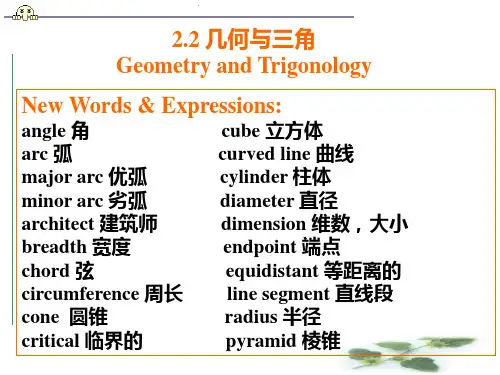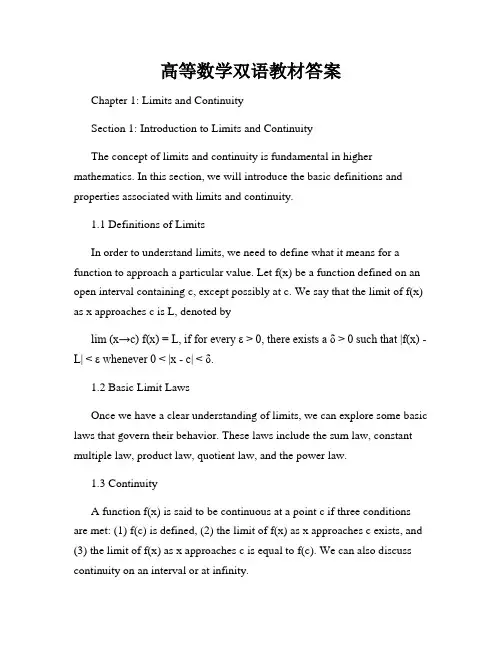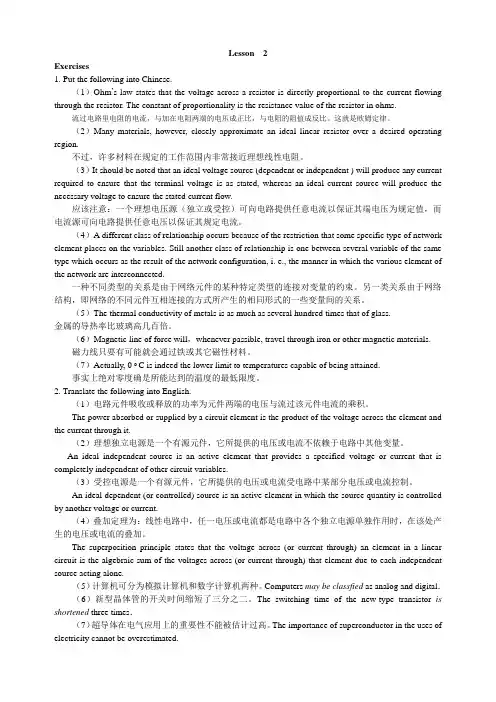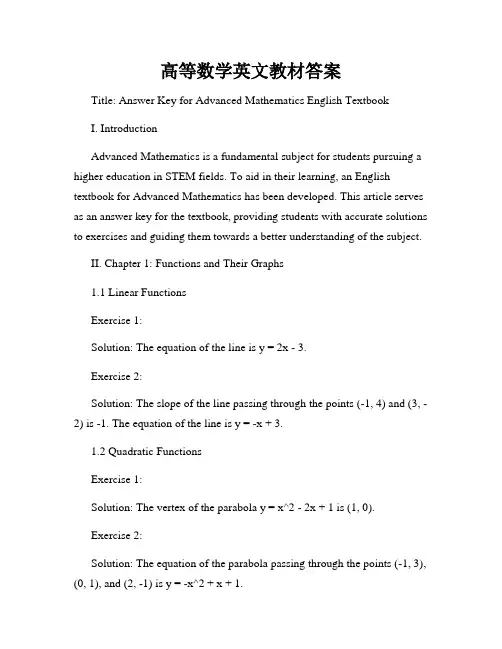数学专业英语课后答案.doc 2
数学专业英语

数学专业英语课后答案2.1数学、方程与比例词组翻译1.数学分支branches of mathematics,算数arithmetics,几何学geometry,代数学algebra,三角学trigonometry,高等数学higher mathematics,初等数学elementary mathematics,高等代数higher algebra,数学分析mathematical analysis,函数论function theory,微分方程differential equation2.命题proposition,公理axiom,公设postulate,定义definition,定理theorem,引理lemma,推论deduction3.形form,数number,数字numeral,数值numerical value,图形figure,公式formula,符号notation(symbol),记法/记号sign,图表chart4.概念conception,相等equality,成立/真true,不成立/不真untrue,等式equation,恒等式identity,条件等式equation of condition,项/术语term,集set,函数function,常数constant,方程equation,线性方程linear equation,二次方程quadratic equation5.运算operation,加法addition,减法subtraction,乘法multiplication,除法division,证明proof,推理deduction,逻辑推理logical deduction6.测量土地to measure land,推导定理to deduce theorems,指定的运算indicated operation,获得结论to obtain the conclusions,占据中心地位to occupy the centric place汉译英(1)数学来源于人类的社会实践,包括工农业的劳动,商业、军事和科学技术研究等活动。
数学专业英语2-2

学生通过几何的学习而达到的最主要目标是:在听, 读,和思考时变得更加审慎。在学习几何的过程中, 他们不再盲目地接受一些陈述和思想,而是在得出结 论之前学会了清楚和审慎的思考。
2-B Some geometrical terms
1. Solids and planes. A solid is a three-dimensional figure. Common examples of solids are cube, sphere, cylinder, cone and pyramid.
点没有长度,宽度和厚度,但是标记了一个位置。我们熟悉铅 笔尖,针尖这样的表达。我们可以用一个小圆点来表示一个点, 在它旁边用打印体大写字母来命名,如图2-2-1中的点A。
The line is named by labeling two points on it with capital letters or one small letter near it. The straight line extends infinitely far in two directions and has no ends. The part of the line between two points on the line is termed a line segment.
有三种线:直线,折线和曲线。曲线是指其中没有任何部分是 直的。折线是由连起来的直线段构成,如图2-2-3中的ABCDE.
数学专业英语课后答案

数学专业英语课后答案1、He kept walking up and down, which was a sure()that he was very worried. [单选题] *A. sign(正确答案)B. characterC. natureD. end2、20.Jerry is hard-working. It’s not ______ that he can pass the exam easily. [单选题] * A.surpriseB.surprising (正确答案)C.surprisedD.surprises3、--What’s the weather like today?--It’s _______. [单选题] *A. rainB. windy(正确答案)C. sunD. wind4、Many of my classmates are working _______volunteers. [单选题] *A. as(正确答案)B. toC. atD. like5、Mary is interested ______ hiking. [单选题] *A. onB. byC. in(正确答案)D. at6、We need a _______ when we travel around a new place. [单选题] *A. guide(正确答案)B. touristC. painterD. teacher7、While they were in discussion, their manager came in by chance. [单选题] *A. 抓住时机C. 碰巧(正确答案)D. 及时8、Our campus is _____ big that we need a bike to make it. [单选题] *A. veryB. so(正确答案)C. suchD. much9、57.Next week will be Lisa's birthday. I will send her a birthday present ________ post. [单选题] *A.withB.forC.by(正确答案)D.in10、The manager demanded that all employees _____ on time. [单选题] *A. be(正确答案)B. areC. to be11、He has two sisters but I have not _____. [单选题] *A. noneB. someC. onesD. any(正确答案)12、______! It’s not the end of the world. Let’s try it again.()[单选题] *A. Put upB. Set upC. Cheer up(正确答案)D. Pick up13、My brother usually _______ his room after school. But now he _______ soccer. [单选题] *A. cleans; playsB. cleaning; playingC. cleans; is playing(正确答案)D. cleans; is playing the14、The museum is _______ in the northeast of Changsha. [单选题] *A. sitB. located(正确答案)C. liesD. stand15、______ my great joy, I met an old friend I haven' t seen for years ______ my way ______ town. [单选题] *A. To, in, forB. To, on, to(正确答案)C. With, in, toD. For, in, for16、In the closet()a pair of trousers his parents bought for his birthday. [单选题] *A. lyingB. lies(正确答案)c. lieD. is lain17、44.—Hi, Lucy. You ________ very beautiful in the new dress today.—Thank you very much. [单选题] *A.look(正确答案)B.watchC.look atD.see18、They all choose me ______ our class monitor.()[单选题] *A. as(正确答案)B. inC. withD. on19、My mother’s birthday is coming. I want to buy a new shirt ______ her.()[单选题] *A. atB. for(正确答案)C. toD. with20、--Could you please tell me _______ to get to the nearest supermarket?--Sorry, I am a stranger here. [单选题] *A. whatB. how(正确答案)C. whenD. why21、?I am good at schoolwork. I often help my classmates _______ English. [单选题] *A. atB. toC. inD. with(正确答案)22、He was very excited to read the news _____ Mo Yan had won the Nobel Prize for literature [单选题] *A. whichB. whatC. howD. that(正确答案)23、Becky is having a great time ______ her aunt in Shanghai. ()[单选题] *A. to visitB. visitedC. visitsD. visiting(正确答案)24、In the future, people ______ a new kind of clothes that will be warm when they are cold, and cool when they’re hot.()[单选题] *A. wearB. woreC. are wearingD. will wear(正确答案)25、This message is _______. We are all _______ at it. [单选题] *A. surprising; surprisingB. surprised; surprisedC. surprising; surprised(正确答案)D. surprised; surprising26、Your homework must_______ tomorrow. [单选题] *A. hand inB. is handed inC. hands inD. be handed in(正确答案)27、Since the war their country has taken many important steps to improve its economic situation. [单选题] *A. 制定B. 提出C. 讨论D. 采取(正确答案)28、How _______ Grace grows! She’s almost as tall as her mother now. [单选题] *A. cuteB. strongC. fast(正确答案)D. clever29、_____ is not known yet. [单选题] *A. Although he is serious about itB. No matter how we will do the taskC. Whether we will go outing or not(正确答案)D. Unless they come to see us30、You cannot see the doctor _____ you have made an appointment with him. [单选题] *A. exceptB.evenC. howeverD.unless(正确答案)。
高等数学双语教材答案

高等数学双语教材答案Chapter 1: Limits and ContinuitySection 1: Introduction to Limits and ContinuityThe concept of limits and continuity is fundamental in higher mathematics. In this section, we will introduce the basic definitions and properties associated with limits and continuity.1.1 Definitions of LimitsIn order to understand limits, we need to define what it means for a function to approach a particular value. Let f(x) be a function defined on an open interval containing c, except possibly at c. We say that the limit of f(x) as x approaches c is L, denoted bylim (x→c) f(x) = L, if for every ε > 0, there exists a δ > 0 such that |f(x) - L| < ε whenever 0 < |x - c| < δ.1.2 Basic Limit LawsOnce we have a clear understanding of limits, we can explore some basic laws that govern their behavior. These laws include the sum law, constant multiple law, product law, quotient law, and the power law.1.3 ContinuityA function f(x) is said to be continuous at a point c if three conditions are met: (1) f(c) is defined, (2) the limit of f(x) as x approaches c exists, and (3) the limit of f(x) as x approaches c is equal to f(c). We can also discuss continuity on an interval or at infinity.Chapter 2: DifferentiationSection 1: Introduction to DifferentiationDifferentiation is an important concept in calculus that allows us to find the rate at which a function is changing at any given point. In this section, we will introduce the concept of differentiation and its applications.2.1 Derivative DefinitionThe derivative of a function f(x) at a point c is defined as the limit of the difference quotient as h approaches 0. Mathematically, this can be written as f'(c) = lim (h→0) [(f(c + h) - f(c))/h].2.2 Differentiation RulesThere are several rules that allow us to find the derivative of a function quickly. These rules include the constant rule, power rule, sum rule, difference rule, product rule, quotient rule, and chain rule.2.3 Applications of DifferentiationDifferentiation has many applications in various fields, such as physics, economics, and engineering. It can be used to find maximum and minimum values, determine rates of change, and solve optimization problems.Chapter 3: IntegrationSection 1: Introduction to IntegrationIntegration is the reverse process of differentiation. It enables us to find the area under a curve and solve various mathematical problems. In this section, we will introduce the concept of integration and its applications.3.1 Indefinite IntegralsThe indefinite integral of a function f(x) is the collection of all antiderivatives of f(x). It is denoted by ∫ f(x) dx and represents a family of functions rather than a single value.3.2 Integration TechniquesThere are various techniques for finding antiderivatives and evaluating definite integrals. These techniques include basic integration rules, substitution, integration by parts, and trigonometric substitution.3.3 Applications of IntegrationIntegration has numerous applications, such as finding the area between two curves, calculating the length of curves, determining volumes of solids, and solving differential equations.ConclusionIn conclusion, the study of high-level mathematics, particularly limits, continuity, differentiation, and integration, is crucial for a comprehensive understanding of advanced mathematical concepts. This article has provided a brief overview of these topics, highlighting their definitions, properties, and applications. By mastering these concepts, students can develop strong problem-solving skills and apply them in various academic and real-world scenarios.。
专业英语课后习题答案

1. Put the following into Chinese.(1)Ohm’s law states that the voltage across a resistor is directly proportional to the current flowing through the resistor. The constant of proportionality is the resistance value of the resistor in ohms.流过电路里电阻的电流,与加在电阻两端的电压成正比,与电阻的阻值成反比。
这就是欧姆定律。
(2)Many materials, however, closely approximate an ideal linear resistor over a desired operating region.不过,许多材料在规定的工作范围内非常接近理想线性电阻。
(3)It should be noted that an ideal voltage source (dependent or independent ) will produce any current required to ensure that the terminal voltage is as stated, whereas an ideal current source will produce the necessary voltage to ensure the stated current flow.应该注意:一个理想电压源(独立或受控)可向电路提供任意电流以保证其端电压为规定值,而电流源可向电路提供任意电压以保证其规定电流。
(4)A different class of relationship occurs because of the restriction that some specific type of network element places on the variables. Still another class of relationship is one between several variable of the same type which occurs as the result of the network configuration, i. e., the manner in which the various element of the network are interconnected.一种不同类型的关系是由于网络元件的某种特定类型的连接对变量的约束。
高等数学英文教材答案

高等数学英文教材答案Title: Answer Key for Advanced Mathematics English TextbookI. IntroductionAdvanced Mathematics is a fundamental subject for students pursuing a higher education in STEM fields. To aid in their learning, an English textbook for Advanced Mathematics has been developed. This article serves as an answer key for the textbook, providing students with accurate solutions to exercises and guiding them towards a better understanding of the subject.II. Chapter 1: Functions and Their Graphs1.1 Linear FunctionsExercise 1:Solution: The equation of the line is y = 2x - 3.Exercise 2:Solution: The slope of the line passing through the points (-1, 4) and (3, -2) is -1. The equation of the line is y = -x + 3.1.2 Quadratic FunctionsExercise 1:Solution: The vertex of the parabola y = x^2 - 2x + 1 is (1, 0).Exercise 2:Solution: The equation of the parabola passing through the points (-1, 3), (0, 1), and (2, -1) is y = -x^2 + x + 1.III. Chapter 2: Differentiation2.1 Derivative of FunctionsExercise 1:Solution: The derivative of f(x) = 3x^2 - 2x + 1 is f'(x) = 6x - 2.Exercise 2:Solution: The derivative of g(x) = 5x^3 + 2x^2 - 4x is g'(x) = 15x^2 + 4x - 4.2.2 Rules of DifferentiationExercise 1:Solution: The derivative of h(x) = sin(x) + cos(x) is h'(x) = cos(x) -sin(x).Exercise 2:Solution: The derivative of i(x) = ln(x^2) is i'(x) = 2/x.IV. Chapter 3: Integration3.1 Indefinite IntegralsExercise 1:Solution: The integral of f(x) = 3x^2 - 2x + 1 is F(x) = x^3 - x^2 + x + C, where C is the constant of integration.Exercise 2:Solution: The integral of g(x) = 5x^3 + 2x^2 - 4x is G(x) = x^4/4 +2x^3/3 - 2x^2/2 + C.3.2 Definite IntegralsExercise 1:Solution: The definite integral of h(x) = sin(x) + cos(x) from 0 to π/2 is ∫[0, π/2] (sin(x) + cos(x)) dx = 2.Exercise 2:Solution: The definite integral of i(x) = ln(x) from 1 to e is ∫[1, e] ln(x) dx = 1.V. ConclusionThis answer key provides students using the Advanced Mathematics English textbook with accurate solutions to exercises, enabling them to verify their work and further enhance their understanding of the subject. By following the provided solutions, students can gain confidence in their problem-solving abilities and excel in the field of mathematics.。
高等数学教材答案下册英语
高等数学教材答案下册英语Unit 1: Functions and Their GraphsChapter 1: Linear Functions1.1 Functions and Their Representations1.2 Domain and Range1.3 Linear Functions and EquationsChapter 2: Quadratic Functions2.1 Graphs of Quadratic Functions2.2 Solving Quadratic Equations2.3 Quadratic Functions and Their Transformations Chapter 3: Exponential and Logarithmic Functions3.1 Exponential Functions and Their Graphs3.2 Logarithmic Functions and Their Graphs3.3 Exponential and Logarithmic EquationsUnit 2: Limits and ContinuityChapter 4: Limits and Continuity4.1 Limits and Their Properties4.2 Continuity and Its Properties4.3 Computing LimitsChapter 5: Derivatives5.1 The Derivative and its Interpretation5.2 Differentiation Techniques5.3 Applications of DerivativesChapter 6: Higher-Order Derivatives6.1 Higher-Order Derivatives and Their Interpretations 6.2 The Chain Rule6.3 Implicit DifferentiationUnit 3: IntegrationChapter 7: Antiderivatives and Indefinite Integrals 7.1 Antiderivatives and Their Properties7.2 Indefinite Integrals7.3 Substitution MethodChapter 8: Definite Integrals and Their Applications 8.1 Definite Integrals and Their Properties8.2 Applications of Definite Integrals8.3 Numerical IntegrationChapter 9: Techniques of Integration9.1 Integration by Parts9.2 Trigonometric Integrals9.3 Trigonometric SubstitutionUnit 4: Differential Equations and Applications Chapter 10: First-Order Differential Equations 10.1 Separable Differential Equations10.2 Linear Differential Equations10.3 Applications of Differential Equations Chapter 11: Applications of Differential Calculus 11.1 Optimization11.2 Related Rates11.3 Newton's MethodChapter 12: Sequences and Series12.1 Sequences and Their Limits12.2 Infinite Series12.3 Convergence TestsUnit 5: Multivariable CalculusChapter 13: Functions of Several Variables 13.1 Functions of Two or More Variables13.2 Partial Derivatives13.3 Optimization of Functions of Two VariablesChapter 14: Multiple Integrals14.1 Double Integrals14.2 Triple Integrals14.3 Applications of Multiple IntegralsChapter 15: Vector Calculus15.1 Vector Fields15.2 Line Integrals15.3 Green's TheoremChapter 16: Differential Calculus of Vector Fields16.1 Gradient Fields and Potential Functions16.2 Divergence and Curl16.3 Stokes' TheoremI hope the above chapters and sections provide a comprehensive overview of the answers to the exercises and problems in the textbook. Remember to utilize this answer key as a useful tool to check your understanding and progress in studying advanced mathematics.。
高等数学的英文版教材答案
高等数学的英文版教材答案I. Introduction to Higher MathematicsHigher Mathematics is a fundamental subject that plays a crucial role in various fields of study, such as engineering, physics, economics, and computer science. To fully comprehend the concepts and principles of Higher Mathematics, it is essential to have access to accurate and comprehensive textbooks. This article aims to provide an overview of the English version of a Higher Mathematics textbook, focusing on its content, structure, and the importance of having reliable answer keys.II. Content of the English Version of Higher Mathematics TextbookThe English version of the Higher Mathematics textbook covers a wide range of mathematical topics, including calculus, linear algebra, differential equations, probability theory, and mathematical modeling. Each chapter delves into specific concepts and provides detailed explanations, accompanied by illustrative examples to enhance understanding.1. Calculus:The section on calculus is divided into differential calculus and integral calculus. It introduces key principles such as limits, derivatives, and integrals. Various calculus techniques, such as the chain rule, product rule, and fundamental theorem of calculus, are thoroughly explained.2. Linear Algebra:The linear algebra section encompasses topics like vector spaces, matrices, determinants, and eigenvalues. It illustrates the fundamentaltheories of linear algebra and introduces essential concepts, including linear transformations, spanning sets, and eigenvectors.3. Differential Equations:In the differential equations chapter, students learn about different types of differential equations, such as first-order, second-order, and higher-order equations. The solution methods for both homogeneous and non-homogeneous equations are outlined, along with applications in various fields.4. Probability Theory:The section on probability theory introduces students to basic concepts, such as random variables, probability distributions, and expected values. It covers topics like binomial, Poisson, and normal distributions, enabling students to apply probability theory in real-life situations.5. Mathematical Modeling:The mathematical modeling section explores the process of formulating a mathematical model to describe real-world phenomena. It highlights the importance of applying mathematical techniques to analyze and solve practical problems.III. Structure of the English Version of Higher Mathematics TextbookThe English version of the Higher Mathematics textbook follows a well-organized structure, with each chapter building upon the previous one. It presents complex mathematical content in a systematic manner, ensuring a progressive learning experience for students.1. Chapter Organization:Each chapter begins with an introduction that outlines the key concepts and learning objectives. It is followed by concise explanations and illustrative examples that aid in conceptual understanding. The chapters conclude with a summary of the main points covered, allowing for a quick review.2. Exercises and Problems:Throughout the textbook, numerous exercises and problems are provided to reinforce the learned concepts. Students can practice solving mathematical problems to enhance their problem-solving skills and apply the newly acquired knowledge. The textbook also offers answers to the exercises for self-assessment.IV. Importance of Reliable Answer KeysHaving reliable answer keys is crucial for students studying Higher Mathematics. These answer keys serve as a valuable resource to verify the accuracy of their solutions and improve their problem-solving abilities. Furthermore, they provide immediate feedback, allowing students to identify and rectify any mistakes made during the learning process.V. ConclusionThe English version of the Higher Mathematics textbook serves as a comprehensive guide for students studying Higher Mathematics. With its well-structured content, illustrative examples, and reliable answer keys, the textbook enhances students' understanding of mathematical concepts and facilitates their learning experience. It equips them with essential skillsrequired for various fields, enabling them to excel in their academic and professional pursuits.。
数学专业英语答案之2.2 几何与三角
2.2 几何与三角词组翻译1.学会institution,建筑师 architect, 机械师 machinist, 制图员draftsman, 测量者surveyor, 木匠carpenter2.点point, 端点endpoint, 线line, 直线straight line, 线段 line segment, 曲线curved line, 折线 broken line, 射线ray , 平面 plane,曲面 curved surface3.立体solid, 柱体cylinder, 立方体cube,球 sphere, 棱锥pyramid,圆锥 cone ,4.圆circle,圆心 center, 直径diameter, 半径radius, 半圆semicircle, 弦chord, 弧arc, 优弧major arc, 劣弧minor arc5.角angle, 边side, 三角形triangle, 直角三角形right triangle,斜边 hypotenuse, 直角边right-angle side6.长度length,宽度 breadth/width,厚度 thickness, 位置position7.几何的geometrical,立体的 three-dimensional , 弯曲的curved,等距离的equidistant ,无限的 infinite8.培养创造力train originality,必须的毅力 necessary perseverance , 提高鉴赏力raise/improve the appreciation ability9.消失了的边界vanishing boundaries/landmarks,有序性和优美感 orderliness and sense of beauty, 几何图形大量存在geometric forms abound in , 定理成立的先决条件a prerequisite to a theorem 汉译英1.许多专家都认为数学是学习其他科学技术的必备基础和先决条件。
数学专业英语
专业英语1/2 :a half 或one half1/4:a quarter(fourth)或one quarter(fourth) 1/1234:one over a thousand two hundred and thirty-four4/5:four fifths 或four over five113/300:one hundred and thirteen over three Hundred872:two and seven over eight 或two andseven eighths20o :wenty degrees 6’ :six minutes; six feet 10” :ten seconds; ten inches 2% :two percent 5‰:five per millea +b a plus b; (positive)a -b a minus b; (negative) a±b a plus or minus b a×b a multiplied by b; (times) a÷b a divided by b;a:b the ratio of a to ba=b a is equal to b; a equals to b a ≠b a is not equal to b; a is not b a >b a is greater than ba <b a is less than ba ≣b a is greater than or equal to b a ≢b a is less than or equal to ba ≡b a is identically equal to b; a is of identity to ba ba is approximately equal to bsquare root of an th root of aa the absolute value of aalgebra 代数学 geometrical 几何的algebraic 代数的 identity 恒等式arithmetic 算术, 算术的 measure 测量,测度axiom 公理numerical 数值的, 数字的conception 概念,观点 operation 运算 constant 常数 postulate 公设logical deduction 逻辑推理 proposition 命题division 除,除法 subtraction 减,减法 formula 公式term 项,术语trigonometry 三角学 variable 变化的,变量angle 角 cube 立方体arc 弧 curved line 曲线major arc 优弧 cylinder 柱体minor arc 劣弧 diameter 直径architect 建筑师 dimention 维数,大小breadth 宽度 endpoint 端点chord 弦 equidistant 等距离的circumference 周长 line segment 直线段cone 圆锥 radius 半径critical 临界的 pyramid 棱锥 ray 射线 sphere 球,球面semicircle 半圆 surface 面,曲面solid 立体的,立体 thickness 厚度brace 大括号 roster 名册consequence 结论,推论roster notation 枚举法designate 标记,指定rule out 排除,否决diagram 图形,图解subset 子集distinct 互不相同的the underlying set 基础集distinguish 区别,辨别universal set 全集divisible 可被除尽的validity 有效性dummy 哑的,哑变量visual 可视的even integer 偶数visualize 可视化irrelevant 无关紧要的void set(empty set) 空集conversely 反之geometric interpretation 几何意义correspond 对应induction 归纳法deducible 可推导的proof by induction 归纳证明difference 差inductive set 归纳集distinguished 著名的inequality 不等式entirely complete 完整的integer 整数Euclid 欧几里得interchangeably 可互相交换的Euclidean 欧式的intuitive直观的the field axiom 域公理irrational 无理的irrational number 无理数rational 有理的the order axiom 序公理rational number 有理数ordered 有序的reasoning 推理product 积scale 尺度,刻度quotient 商sum 和abscissa 横坐标horizontal 水平的analytic geometry 解析几何hypotenuse 斜边arbitrary 任意的integral 整数的,积分的,积分Cartesian 笛卡儿的intersect 相交Rene Descartes 笛卡儿intertwine 融合,结合circular 圆的,圆周的leg 侧边,直角边coordinate 坐标ordinate 纵坐标the origin 坐标原点segment 线段parabolic 抛物线的three-dimensional 三维的perpendicular 垂直的triangle 三角形polygonal 多边形的the unit distance 单位长度quadrant 象限vector 向量, 矢量reduce 归结,化简vertical 竖直的课后答案2-1(1)数学来源于人类的社会实践,包括工农业的劳动,商业、军事和科学技术研究等活动。
- 1、下载文档前请自行甄别文档内容的完整性,平台不提供额外的编辑、内容补充、找答案等附加服务。
- 2、"仅部分预览"的文档,不可在线预览部分如存在完整性等问题,可反馈申请退款(可完整预览的文档不适用该条件!)。
- 3、如文档侵犯您的权益,请联系客服反馈,我们会尽快为您处理(人工客服工作时间:9:00-18:30)。
2.1 数学、方程与比例(1)数学来源于人类的社会实践,包括工农业的劳动,商业、军事和科学技术研究等活动。
Mathematics comes from man’s social practice, for example, industrial and agricultural production, commercial activities, military operations and scientific and technological researches.(2)如果没有运用数学,任何一个科学技术分支都不可能正常地发展。
No modern scientific and technological branches could be regularly developed without the application of mathematics.(3)符号在数学中起着非常重要的作用,它常用于表示概念和命题。
Notations are a special and powerful tool of mathematics and are used to express conceptions and propositions very often.(4)17 世纪之前,人们局限于初等数学,即几何、三角和代数,那时只考虑常数。
Before 17th century, man confined himself to the elementary mathematics, i. e. , geometry, trigonometry and algebra, in which only the constants were considered. (5)方程与算数的等式不同在于它含有可以参加运算的未知量。
Equation is different from arithmetic identity in that it contains unknown quantity which can join operations.(6)方程又称为条件等式,因为其中的未知量通常只允许取某些特定的值。
Equipment is called an equation of condition in that it is true only for certain values of unknown quantities in it.(7)方程很有用,可以用它来解决许多实际应用问题。
Equations are of very great use. We can use equations in many mathematical problems.(8)解方程时要进行一系列移项和同解变形,最后求出它的根,即未知量的值。
To solve the equation means to move and change the terms about without making the equation untrue, until the root of the equation is obtained, which is the value of unknown term.2.3 集合论的基本概念(1)由小于10 且能被 3 整除的正整数组成的集是整数集的子集。
The set consisting of those positive integers less than 10 which are divisible by 3 is a subset of the set of all integers.(2)如果方便,我们通过在括号中列举元素的办法来表示集。
When convenient, we shall designate sets by displaying the elements in braces. (3)用符号⊆表示集的包含关系,也就是说,式子 A ⊆ B 表示 A 包含于B。
The relation ⊆is referred to as set inclusion; A⊆B means that A is contained in B. (4)命题 A ⊆ B 并不排除 B ⊆ A 的可能性。
The statement A⊆B does not rule out the possibility that B⊆A.(5)基础集可根据使用场合不同而改变。
The underlying set may vary from one application to another according to using occasions.(6)为了避免逻辑上的困难,我们必须把元素x 与仅含有元素x 的集{x}区别开来。
To avoid logical difficulties, we must distinguish between the element x and the set {x} whose only element is x.(7)图解法有助于将集合之间的关系形象化。
Diagrams often help using visualize relationship between sets.(8)定理的证明仅仅依赖于概念和已知的结论,而不依赖于图形。
The proofs of theorems rely only on the definitions of the concepts and known result, not on the diagrams.2.4 整数、有理数与实数整数(1)严格说,这样描述整数是不完整的,因为我们并没有说明“依此类推”或“反复加1” 的含义是什么。
Strictly speaking, this description of the positive integers is not entirely complete because we have not explained in detail what we mean by the express ions “and so on”, or “repeated addition of 1”.(2)两个整数的和、差或积是一个整数,但是两个整数的商未必是一个整数。
The sum, difference, or product of two integers is an integer, but the quotient of two integers need not be an integer.(3)这种用几何来表示实数的办法对于帮助我们更好地发现与理解实数的性质是非常有价值的。
This device for representing real numbers geometrically is a very worthwhile aid that helps us to discover and understand better certain properties of real numbers.(4)几何经常为一些特定的定理提供证明思路(建议),而且,有时几何的论证比纯分析的(完全依赖于实数公理的)证明更清晰。
The geometry often suggests the method of proof of a particular theorem, and sometimes a geometric argument is more illuminating than a purely analytic proof (one depending entirely on the axioms for the real numbers).(5)一个由实数组成的集若满足如下条件则称为开区间(open interval)。
If a set consisting of real numbers satisfies the following conditions we call it an open interval.(6)实数 a 是-a 的相反数,它们的绝对值相等,且当 a ≠ 0 时,其符号不同。
The real number a is the negative number of –a and their absolute values are equal. When a ≠ 0, their notations are different.(7)每个实数刚好对应着实轴上的一点,反之,对实轴上的每一点,有且只有一个实数与之对应。
Each real number corresponds to exactly one point on this line and, conversely, each point on the line corresponds to one and only one real number.(8)在几何上,实数之间的次序关系可以在数轴上清楚地表示出来。
In geometry, the ordering relation among the real numbers can be expressed clearly in real axis.2.5 笛卡儿几何学的基本概念(1)计算图形的面积是积分的一种重要应用。
The calculation of figure area is the important application of the integral.(2)在x-轴上O 点右边选定一个适当的点,并把它到O 点的距离称为单位长度。
On the x-axis a convenient point is chosen to the right of O and its distance from O is called the unit distance.(3)对xy-平面上的每一个点都指定了一个数对,称为它的坐标。
Each point in the xy-plane is assigned a pair of numbers, called its coordinates.(4)选取两条互相垂直的直线,其中一条是水平的,另一条是竖立的,把它们的交点记作O,称为原点。
Two perpendicular reference lines are chosen, one horizontal, the other vertical. Their point of intersection, denoted by O, is called the origin.(5)当我们用一对数(a, b)来表示平面的点时,商定要把横坐标写在第一个位置上。
